Hearn Lafcadio
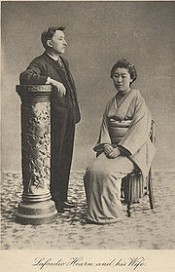
Patrick Lafcadio Hearn (27 June 1850 – 26 September 1904), also known as Koizumi Yakumo (小泉八雲?) after gaining Japanese citizenship, was an author, best known for his books about Japan. He is especially well-known for his collections of Japanese legends and ghost stories, such as Kwaidan: Stories and Studies of Strange Things. Hearn was born in Lefkada (the origin of his middle name), one of the Greek Ionian Islands. He was the son of Surgeon-major Charles Bush Hearn (of County Offaly, Ireland) and Rosa Antoniou Kassimati, a Greek woman of noble Cerigote lineage through her father[1] , Anthony Cassimati, who had been born on Kythera, an island in the Myrtoon Pelagos (currently in the municipality of Athens). His father was stationed in Lefkada during the British occupation of the islands. Lafcadio was initially baptized Patricio Lefcadio Hearn in the Greek Orthodox Church. It is not clear that Hearn's parents were ever legally married, and the Irish Protestant relatives on his father's side considered him to have been born out of wedlock. (This may, however, have been because they did not recognize the legitimacy of the Greek Orthodox Church to conduct a marriage ceremony for a Protestant.)[2] Hearn moved to Dublin, Ireland, at the age of two, where he was brought up in the suburb of Rathmines. Other members of his family also pursued artistic and bohemian interests. His father's brother Richard was at one time a well-known member of the Barbizon set of artists, though he made no mark as a painter, possibly due to a lack of personal ambition. Young Hearn had a rather casual education, but in 1865 was at Ushaw Roman Catholic College, Durham. He was injured in a playground accident in his teens, causing loss of vision in his left eye. The religious faith in which he was brought up was, however, soon lost, and at 19 he was sent to live in the United States of America, where he settled in Cincinnati, Ohio. For a time, he lived in utter poverty, which may have contributed to his later paranoia and distrust of those around him . He eventually found a friend in the English printer and communalist Henry Watkin. With Watkin's help, Hearn picked up a living in the lower grades of newspaper work. Through the strength of his talent as a writer, Hearn quickly advanced through the newspaper ranks and became a reporter for the Cincinnati Daily Enquirer, working for the paper from 1872 to 1875. With creative freedom in one of Cincinnati's largest circulating newspapers, he developed a reputation as the paper's premier sensational journalist, as well as the author of sensitive, dark, and fascinating accounts of Cincinnati's disadvantaged. He continued to occupy himself with journalism and with out-of-the-way observation and reading, and meanwhile his erratic, romantic, and rather morbid idiosyncrasies developed. While in Cincinnati, he married Alethea ("Mattie") Foley, a black woman, an illegal act at the time. When the scandal was discovered and publicized, he was fired from the Enquirer and went to work for the rival Cincinnati Commercial. In 1874 Hearn and the young Henry Farny, later a renowned painter of the American West, wrote, illustrated, and published a weekly journal of art, literature, and satire they titled Ye Giglampz that ran for nine issues. The Cincinnati Public Library reprinted a facsimile of all nine issues in 1983. In the autumn of 1877, Hearn left Cincinnati for New Orleans, Louisiana, where he initially wrote dispatches on his discoveries in the "Gateway to the Tropics" for the Cincinnati Commercial. He lived in New Orleans for nearly a decade, writing first for the Daily City Item and later for the Times Democrat. The vast number of his writings about New Orleans and its environs, many of which have not been collected, include the city's Creole population and distinctive cuisine, the French Opera, and Vodou. His writings for national publications, such as Harper's Weekly and Scribner's Magazine, helped mold the popular image of New Orleans as a colorful place with a distinct culture more akin to Europe and the Caribbean than to the rest of North America. His best-known Louisiana works are Gombo Zhèbes, Little Dictionary of Creole Proverbs in Six Dialects (1885); La Cuisine Créole (1885), a collection of culinary recipes from leading chefs and noted Creole housewives who helped make New Orleans famous for its cuisine; and Chita: A Memory of Last Island, a novella based on the hurricane of 1856 first published in Harper's Monthly in 1888. He also published in Harper's Weekly the first known written article (1883) about Filipinos in the United States, the Manilamen or Tagalags, one of whose villages he had visited at Saint Malo, southeast of Lake Borgne in Saint Bernard Parish, Louisiana. Little known then, even today he is relatively unknown outside the circle of New Orleans cultural devotees. However, more books have been written about him than any former resident of New Orleans other than Louis Armstrong. His footprint in the history of Creole cooking is visible even today.[3] Hearn's writings for the New Orleans newspapers included impressionistic sketches of New Orleans places and characters and many stern, vigorous editorials denouncing political corruption, street crime, violence, intolerance and the failures of public health and hygiene officials. Despite the fact that Hearn is credited with "inventing" New Orleans as an exotic and mysterious place, his obituaries on the vodou leaders Marie Laveau and "Doctor" John Montenet are matter-of-fact and debunking. Dozens of Hearn's New Orleans writings are collected in Inventing New Orleans: Writings of Lafcadio Hearn, a book edited by S. Fredrick Starr and published in 2001 by the University Press of Mississippi. (Professor Starr's scholarly introduction to Inventing New Orleans notes than many Japanese scholars of Hearn's life and work are now studying his decade in New Orleans.)[4] Harper's sent Hearn to the West Indies as a correspondent in 1887. He spent two years in Martinique and produced two books: Two Years in the French West Indies and Youma, The Story of a West-Indian Slave, both in 1890. In 1890, Hearn went to Japan with a commission as a newspaper correspondent, which was quickly broken off. It was in Japan, however, that he found his home and his greatest inspiration. Through the goodwill of Basil Hall Chamberlain, Hearn gained a teaching position in the summer of 1890 at the Shimane Prefectural Common Middle School and Normal School in Matsue, a town in western Japan on the coast of the Sea of Japan. Most Japanese identify Hearn with Matsue, as it was here that his image of Japan was molded. Today, the Lafcadio Hearn Memorial Museum and his old residence are still two of Matsue's most popular tourist attractions. During his 15-month stay in Matsue, Hearn married Koizumi Setsu, the daughter of a local samurai family, and became a naturalized Japanese, taking the name Koizumi Yakumo. In late 1891, Hearn took another teaching position in Kumamoto, Kyushu, at the Fifth Higher Middle School, where he spent the next three years and completed his book Glimpses of Unfamiliar Japan (1894). In October 1894 he secured a journalism position with the English-language Kobe Chronicle, and in 1896, with some assistance from Chamberlain, he began teaching English literature at Tokyo (Imperial) University, a post he held until 1903. In 1904, he was a professor at Waseda University. On September 26, 1904, he died of heart failure at the age of 54. In the late 19th century Japan was still largely unknown and exotic to the Western world. However, with the introduction of Japanese aesthetics, particularly at the Paris World's Fair of 1900, the West developed an insatiable appetite for exotic Japan. Consequently, Hearn became known to the world through the depth, originality, sincerity, and charm of his writings. In later years, some critics would accuse Hearn of exoticizing Japan, but as the man who offered the West some of its first glimpses into pre-industrial and Meiji Era Japan, his work still offers valuable insight today. The Japanese director Masaki Kobayashi adapted four Hearn tales into his 1965 film, Kwaidan. Some of his stories have been adapted by Ping Chong into his trademark puppet theatre, including the 1999 Kwaidan and the 2002 OBON: Tales of Moonlight and Rain. Hearn's life and works were celebrated in The Dream of a Summer Day, a play that toured Ireland in April and May 2005, which was staged by the Storytellers Theatre Company and directed by Liam Halligan. It is a detailed dramatization of Hearn's life, with four of his ghost stories woven in. Yone Noguchi is quoted as saying about Hearn, "His Greek temperament and French culture became frost-bitten as a flower in the North."[5] There is also a cultural center named for Hearn at the University of Durham. Hearn was a major translator of the short stories of Guy de Maupassant.[6] In Ian Fleming's 1964 novel You Only Live Twice, James Bond retorts to his nemesis Blofeld's comment of "Have you ever heard the Japanese expression kirisute gomen?" with "Spare me the Lafcadio Hearn, Blofeld."
do you like this author?
What readers are saying
What do you think? Write your own comment on this book!
write a commentWhat readers are saying
What do you think? Write your own comment on this author!
write a commentBook list

The Romance of the Milky WayAnd Other Studies & Stories
Series:
Unknown
Year:
Unknown
Raiting:
4.5/5
Show more
add to favoritesadd In favorites

Books and Habits,from the Lectures of Lafcadio Hearn
Series:
Unknown
Year:
Unknown
Raiting:
2.5/5
Show more
add to favoritesadd In favorites
Book list

The Romance of the Milky WayAnd Other Studies & Stories
Series:
Unknown
Year:
Unknown
Raiting:
4.5/5
Show more
add to favoritesadd In favorites

Books and Habits,from the Lectures of Lafcadio Hearn
Series:
Unknown
Year:
Unknown
Raiting:
2.5/5
Show more
add to favoritesadd In favorites
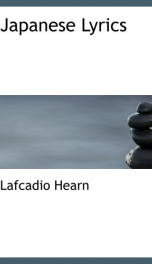
japanese lyrics
Series:
Unknown
Year:
Unknown
Raiting:
2.5/5
Having fully immersed himself in Japanese life, with which he was thoroughly smitten, Westerner Lafcadio Hearn came to occupy a unique position from which he could offer the English-speaking world a personal glimpse beyond the silk curtain and into the heart of the Far East. Known as a superlative purveyor of the Japanese aesthetic sense, Hearn, a sensitive and sincere wordsmith, captures the simple delicacy and earthy realism of Japanese poetry, both contemporary and ancient. The verses collected here traverse the familiar terrain of spirituality, love, and longing, but also venture off the beaten path into the whimsy of lullabies, and as far afield as the alluring realm of "Goblin Poetry." Bohemian and writer PATRICK LAFCADIO HEARN (1850-1904) was born in Greece, raised in Ireland, and worked as newspaper reporter in the United States before decamping to Japan. He also wrote In Ghostly Japan (1899), and Kwaidan (1904). --This text refers to an alternate Paperback edition.
Show more
add to favoritesadd In favorites
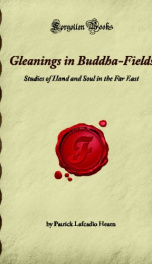
gleanings in buddha fields studies of hand and soul in the far east
Series:
Unknown
Year:
Unknown
Raiting:
1.5/5
Book Description: "The third book of Lafcadio Hearn's Japanese period, Gleanings in Buddha-Fields is a volume of philosophical essays and sketches inspired by the teachings of Buddha. Through a series of loosely connected essays, the author offers readers a wealth of insights into Japanese life, art and religion. When the book was first published in 1897, it attracted the attention of The New York Times: "It is only Mr. Hearn who has made us understand something of the Japanese way of looking at life and things, something of that religion which is the very soul and substance of Japanese existence, thought, and action." Today's readers are sure to recognize the elegance and depth of thought which have made the work a classic." (Quote from columbia.edu)Table of Contents: Publishers Preface; A Living God; Out Of The Street; Notes Of A Trip To KyÔto; Dust; About Faces In Japanese Art; NingyÔ-no-haka; In Ôsaka; Buddhist Allusions In Japanese Folk-song; Nirvana A Study In Synthetic Buddhism; The Rebirth Of KatsugorÔ; Within The Circle; EndnotesAbout the Publisher: Forgotten Books is a publisher of historical writings, such as: Philosophy, Classics, Science, Religion, Esoteric and Mythology. www.forgottenbooks.orgForgotten Books is about sharing information, not about making money. All books are priced at wholesale prices. We are also the only publisher we know of to print in large sans-serif font, which is proven to make the text easier to read and put less strain on your eyes.
Show more
add to favoritesadd In favorites
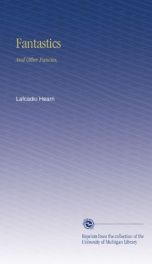
fantastics and other fancies
Series:
Unknown
Year:
Unknown
Raiting:
2.5/5
A posthumous collection of 36 early works by Patrick Lafcadio Hearn, also known as Koizumi Yakumo European-born American-Japanese author, orientalist and philosopher, who wrote novels and articles with exotic themes in highly precise and polished prose. Lyrical and passionate, these brief romantic sketches can be regarded as prose poems. The “Fantastics” proper and the “Other fancies” have been grouped indiscriminately in chronological order, though differing greatly in spirit and in excellence of style. But it is not alone the charm that clings about all that is weird and fanciful that gives value to this early work of Hearn’s. It sheds rich light upon one phase of his development and forms an essential part of his biography; and it helps to furnish proof, along with much else of varying form and excellence that he put forth a vast deal of literary effort in the years of his stay in New Orleans…
Show more
add to favoritesadd In favorites
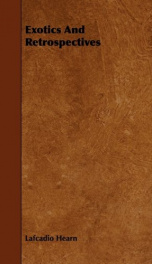
exotics and retrospectives
Series:
Unknown
Year:
Unknown
Raiting:
2.5/5
An enjoyable collection of articles by Patrick Lafcadio Hearn, also known as Koizumi Yakumo European-born American-Japanese author, orientalist and philosopher, who wrote novels and articles with exotic themes in highly precise and polished prose. His 1898 “Exotics and Retrospectives” inquires into Japanese culture, way of life, traditions, religion, nature and folklore. Hearn offers us to follow him in his reflections of why we remember the beautiful more than the ugly, why the color make us feel so strongly, his reflections on an impressive sunset, fear of the supernatural and a lot of other amusing and sometimes mysterious subjects.
Show more
add to favoritesadd In favorites
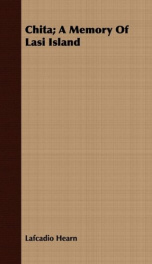
chita a memory of lasi island
Series:
Unknown
Year:
Unknown
Raiting:
4/5
Many of the earliest books, particularly those dating back to the 1900s and before, are now extremely scarce and increasingly expensive. We are republishing these classic works in affordable, high quality, modern editions, using the original text and artwork.
Show more
add to favoritesadd In favorites
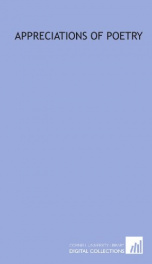
appreciations of poetry
Series:
Unknown
Year:
Unknown
Raiting:
4/5
Originally published in 1908. This volume from the Cornell University Library's print collections was scanned on an APT BookScan and converted to JPG 2000 format by Kirtas Technologies. All titles scanned cover to cover and pages may include marks, notations and other marginalia present in the original volume.
Show more
add to favoritesadd In favorites
What readers are saying
What do you think? Write your own comment on this author!
write a commentif you like Hearn Lafcadio try:
readers also enjoyed
What readers are saying
What do you think? Write your own comment on this author!
write a commentGenre
if you like Hearn Lafcadio try:
readers also enjoyed
Do you want to exchange books? It’s EASY!
Get registered and find other users who want to give their favourite books to good hands!

